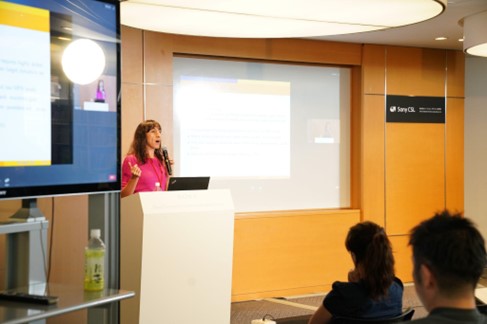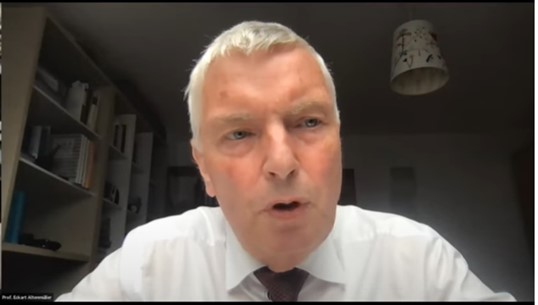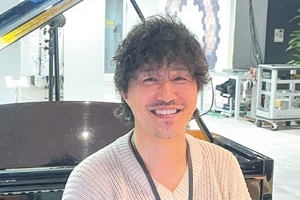Tokyo Research
「Inaugural Musical Dynaformics Workshop」
開催レポート
2023年 8月 29日(金)にソニーコンピュータサイエンス研究所(ソニーCSL)で開催された音楽家のための研究「ダイナフォーミックス」に関する国際ワークショップ ”Inaugural Musical Dynaformics Workshop” のレポートをお届けします。
Musical Dynafomicsは音楽家の熟達支援と故障予防を通して、音楽表現の進化と持続可能性の実現を目指す、東京リサーチリサーチディレクター兼シニアリサーチャーの古屋晋一による研究です。
本ワークショップは演奏家のための研究に関する世界で初めての国際ワークショップとなりました。古屋研究員主催の元、当日は音楽家の科学・医学研究に携わる世界的な研究者らをお招きし、講演とパネルディスカッションが行われました。後編のパネルディスカッションでは登壇者たちによる議論が交わされ、その後Lab TourやGetting Together Partyも開催されました。

【セッション 1 : ピアニストの学習を促す動機づけ要因】
ゲスト:マリア・エロホ・ルイツ教授(ロンドン大学ゴールドスミス校) 英国
学習バイアスと演奏不安
感情や認知の過程で生じる生理学的な変化が、ステージでの音楽演奏の低下にどのように寄与しているか、またそのような異常反応の根底にある神経メカニズムは何か、といったことはまだ解明されていません。ルイツ教授は、そういった不安障害の理解を深める上で「計算精神医学」に基づく研究をされています。
ルイツ教授は本ワークショップで、主に2つの研究テーマについてお話されました。一つは、不安が否定的な学習バイアスと関連しており、否定的なフィードバックや結果から、より素早く学習する傾向があるということです。もう一つは、不確実性に対する誤った評価が、病気の発症と治療への反応の予測に活用できる可能性があることです。

音楽家における否定的学習バイアス
「プレディクティブコーディング」のコンセプトに基づいた実験では、学習バイアスについての興味深い結果が得られました。行動不安のある被験者は過剰なベータ律動を示し、プレディクティブコーディングに則った行動を必ずしも取らないことがわかりました。不安の強い人ほど、肯定的なフィードバックよりも否定的なフィードバックを受けた方がより早く学習する傾向が見られました。
他の実験では、音楽家の被験者全体では肯定的なフィードバックからの学習と否定的なフィードバックからの学習に違いは見られなかった一方で、個人での結果を見てみると不安スコアが非常に低い演奏の場合は、否定的なフィードバックを受けた時の方がより学習が早く進みました。
また、熟練したピアニストに損失や報酬を用いて学習を促進することを目指したピアノ演奏課題を与える実験を行った結果、不安の強いピアニストは「報酬」からより早く学習し、不安の少ないピアニストは「罰」からより早く学習することがわかりました。
音楽演奏不安の薬理学的補助
ルイツ教授は最後に、最新の研究成果も紹介されました。被験者である20人のピアニストが、ベータ受容体を遮断するプロプラノロールを服用して実験を行いました。報酬が少なく、最大限の努力をしなければならないことを知ったピアニストは、ベータ遮断薬を服用した条件では労力の低下が見られました。その一方、プラセボ(偽薬)の条件では最大限の労力の発揮が見られました。神経レベルで労力と報酬に相互作用があることが伺えますが、これはこれまでの猿を対象とした研究ではみられなかった結果です。
さらに、ルイツ教授のチームは、シータ波がエラー処理や損失など多くのタスクに関わっていることに注目しました。シータ波はフィードバックに対する処理に関連しており、損失、少ない報酬、否定的なフィードバックを処理する際にシータ波が増強することが分かっています。しかし、ベータ遮断薬を服用した被験者では高い報酬に対してシータ波が増強しました。このシータ波に関する予想とは逆の反応が、少ない報酬の場合にパフォーマンスが落ちることと関連性があるのかを今後さらに研究するとのことです。
【セッション 2 : 歌唱研究の観点から音楽と神経科学の接点を探る】
ゲスト:ボリス・クレバー教授(デンマーク、オーフス大学) クレバー教授は、音楽演奏における感覚情報処理について研究されています。音楽神経科学の多くの研究が楽器奏者の聴覚モダリティに焦点を当てているのに対し、クレバー教授は歌手に焦点を当てた研究をされてきました。

神経可塑性と脳梁
クレバー教授は過去のデータセットを再調査し、脳梁に関する新しい分析を行いました。その結果、訓練された歌手とアマチュアの歌手では、トレーニングの量と開始時期に脳梁の活動量に違いがあることがわかりました。また、感覚運動野の腹側や背側は発声学習や発声のための運動制御に関連して活性化しますが、これは咽頭の制御だけでなく発話機能や息を吐く機能とも関連していることが新たに分かりました。
さらに、 運動前野の背側と腹側の構造的な結合に関して、過去の演奏経験によって違いが現れるのかどうか調査した結果、仮説通り喉頭運動皮質の背側と腹側の結合に違いが現れることがわかりました。つまり、歌の練習年数や経験によって喉頭運動皮質の構造が変化するということになります。
聴覚と体性感覚フィードバックの関係
また、経験の豊富な歌手やミュージシャンは体制感覚によるフィードバックと聴覚によるフィードバックの両方を活用して細かい運動の制御を行うことが分かっています。
ある実験では、プロの歌手と非歌手を被験者として、音程が変化するのを聞きながら、それを無視して音程を取りつづけようとした結果を比較しました。アマチュアの歌手の場合は主に聴覚野が反応しますが、歌手としての経験が豊富な被験者ほど頭頂葉と前頭前皮質がより活性化する結果となりました。何かしらの意識的な制御メカニズムが働いたことがわかります。
別の実験では、ノイズによって聴覚フィードバックがない状態での被験者の歌唱を調査しました。その結果、聴覚フィードバックがない状態でも、プロの歌手では音程に影響がみられなかった一方、アマチュアの歌手では音程の正確さが低下しました。一般的には聴覚フィードバックをなくすと声を制御するための感覚はほぼなくなりますが、訓練された歌手は感覚運動処理と認知制御に関連している運動前野や島皮質などに活動が見られました。つまり、課題を実施する際に身体からの多様なフィードバックを統合させていたことがわかります。
知覚の違いは生まれつき?
同時に、歌のトレーニングを受けていなくとも身体感覚が優れており、ピッチが優れている人もいることがわかりました。歌手、ヴァイオリニスト、ダンサー、オーケストラ奏者の方がより優れた身体感覚を持つとする研究結果もありますが、訓練量との相関は比較的小さいものです。クレバー教授は、生まれつき備わった知覚と能力を持っている人がいる可能性があると考えており、非常に興味深いと話しました。自分の体をより良く知覚する能力が、音楽スキルの向上に役立つということかもしれません。
【セッション3:音楽家の慢性疼痛の理解と制御】
ゲスト:アンナ・ザモラノ教授(デンマーク、オールボー大学)
ザモラノ教授は、生理学および神経生理学に基づいて、音楽家が慢性疼痛をどのように知覚し対処しているのかを研究しています。
3か月以上続く痛みを慢性疼痛と呼び、環境要因、生物学的要因、心理学的要因があると考えられています。慢性疼痛に苦しむ人の割合は一般では20%であるのに対し、プロの音楽家では60-80%にのぼります。
音楽家の痛みの知覚
熱と圧力を用いた痛みの刺激を使い、慢性疼痛をもつ音楽家と健康な音楽家の痛みへの感度を比較する実験が行われました。その結果、慢性疼痛を持たない健康ピアニストも、慢性疼痛のあるピアニストと同等に感度が増加し、一般の人よりも感度が高いことがわかりました。
また今年発表された研究結果によると、音楽家に感じ取れない程度の微弱な電気刺激を与えた時の脳活動を調べると、非音楽家と比べて大脳皮質の感覚運動野で活動の増加が見られました。音楽家は痛みを感じ取る能力が高いことが伺えます。
音楽家と非音楽家の持的疼痛に対する反応の違い
別の実験では、音楽家と非音楽家の右手に痛みの発現に関与しているといわれるNGF(神経成長因子)を注射し、注射前と3日後および8日後で、痛みをどのように知覚しているかを調査しました。調査の結果、音楽家のみ、大脳皮質で電気刺激に対しての反応が強く見られました。これは、痛みを感じる際の脳の信号伝達経路が、音楽のトレーニングによって変化した可能性を示唆しています。

音楽家の痛みの制御メカニズム
痛みを知覚する際、一般的に重症の傷害を防ぐために皮質運動抑制と呼ばれる逃避反応が起こります。通常、皮質運動抑制が強ければ強いほど痛みは軽減します。しかし、痛みが数時間以上続いた場合、皮質運動抑制が強いほど痛みが高まるという逆の反応がみられるようになります。
手の筋肉の皮質運動制御の実験では、音楽家は大脳皮質の興奮性を抑制することで痛みを軽減していることがわかりました。また慢性疼痛の音楽家は、非音楽家と比べて、島皮質と身体の知覚に関連する脳領域の機能的な結合が弱いことがわかりました。音楽家は、音楽パフォーマンスに関係のない身体の痛みの信号を制御しているということになります。
これらの実験から、音楽家は知覚をボトムアップに信号処理するだけでなく、トップダウンで痛みを制御する制御メカニズムにも優れていると言えるでしょう。それにもかかわらず、多くの音楽家が疼痛症候群に苦しんでいます。ザモラノ教授は、疫学研究の改善、トレーニングやセルフケアの習慣、早期発見や適切な睡眠なども重要だと話しました。
【セッション4:金管楽器奏者の脳のネットワーク柔軟性】
ゲスト:上原一将准教授(豊橋技術科学大学、日本)
上原准教授は長年にわたり、ソニー CSLの古屋研究員とTMS(経頭蓋磁気刺激)に関する共同研究を行ってきました。今回は金管楽器奏者の脳のネットワーク柔軟性についてお話されました。

音楽家のジストニア症状の神経との相関を探る
TMS研究の実験では、一次運動野を刺激し、楽器演奏のMIDIデータを記録して行動特性を評価しました。その結果、音楽家のジストニア患者では運動野のSICI(短間隔皮質内抑制)が減少し、ICF(皮質内促通)が増加していました。また、SICIの減少は指の動きの時間的な不正確さ、ICFの増加は指の滑らかな屈伸運動や、素早い運動の切り替えと関連していることがわかりました。つまり、一次運動野での興奮性-抑制性のバランス(E/Iバランス)の乱れが局所性-動作特異性ジストニア患者の巧妙な動きの喪失に影響していることが考えられます。
fMRI研究の実験では、ジストニアの管楽器奏者における異常な脳活動と体部位局在と症状との関連を調べました。ジストニアの管楽器奏者では、ロングトーンの演奏時に基本周波数の大きな乱れ、不安定さを認めました。
また、一次体性感覚野での脳活動を見てみると、ED患者では手の運動に関する領域が口の動きに関する領域に近づいており、異常な体部位局在が見られました。さらに、ED患者は運動と関連した脳領域での活動量が、健康な演奏者よりも多いことがわかりました。過剰な脳活動を制御することが、ジストニアの症状を緩和する鍵になるかもしれません。
脳ネットワークの柔軟性と熟練した音楽パフォーマンス
脳活動は時々刻々と変化します。このネットワークの柔軟性と呼ばれる神経ダイナミクスを数学的な方法で定量化するため、ネットワークマトリックスを使用して脳内ネットワークの柔軟性の変化を捉え、評価し、脳内ネットワークを計算しました。その結果、シータ波が他の周波数に比べて柔軟であることがわかりました。またフィードバック制御と脳内ネットワークの柔軟性との間に良好な関係があることや、前頭葉、側頭葉、後頭葉といった多くの脳部位がフィードバック制御に貢献していることもわかりました。
このように、脳波(EEG)に基づく脳内ネットワークの柔軟性は、熟練した金管楽器奏者の演奏を予測する能力と紐づいているということになります。この発見を活かして、神経ダイナミクスに基づいて個人のスキルを予測する神経フィードバックシステム等のツールを開発し、音楽トレーニングを向上できる可能性が見えてきました。
協力スキルの特徴を検出するためのディープラーニングアプローチ
さらに、ディープラーニングとEEGデータを活用し、オーケストラ奏者の協力スキルに焦点を当てた神経の研究も行われました。参加者にペアで協力しあうタスクを実施してもらい、それぞれのEEGデータを記録した結果、音楽家はより正確で良い結果を出しました。また、AIでの解析によると、音楽家は協力しあうタスク実行前の準備段階で、重要な脳領域が活動していることがわかりました。
上原准教授は総括として、このように行動の特性を正確に定量化することで、音楽パフォーマンス中の神経活動との相関関係を知るのに役立つと話しました。
【セッション5 : ピアニストのためのエビデンスに基づく身体教育へ向けて】
スピーカー:古屋 晋一(ソニー CSL)、日本
古屋研究員は、音楽家がジストニアや慢性疼痛を乗り越え、創造性の限界を突破し続けるための新しい音楽教育を創ることに取り組んでいます。運動制御の研究者として、若い音楽家のための技術支援と身体教育を提供する”Physical Education for Artist Curriculum(PEAC)”というプログラムを開発しました。科学者、技術者、音楽家と議論を交わしながらより良い音楽教育を実現しながら、研究を行っています。

サイエンスとテクノロジーを活用した身体教育カリキュラム:PEAC
PEACは6つの要素から構成されており、脳、身体、音楽の原理と知識に関するを教える講義を行う「レクチャー」や、音楽的な問題を身体教育の側面から解決に導く「コーチング」の他、4つの要素を紹介しました。
指導支援:骨格の動きを推定するカメラやピアノの鍵盤やペダル内に埋め込んだセンサーなどを使用して、姿勢やタッチを可視化するシステムを提供しています。このシステムを使うことにより、従来は音と言葉のみでは先生が伝えきれなかった表現の機微や身体の使い方を指導者から生徒に伝達可能にし、レッスン中の課題解決を支援します。
練習支援:タッチやペダル、身体の動作を正確に同時記録できるセンサーシステムとアプリケーションで、身体の使い方の探索を効率化し、新たな表現の探索を支援することで創造的な練習を支援します。またモバイルアプリを使用することで、自宅でも腕や身体の姿勢、指の動きを可視化したデータを振り返ることができます。さらに自宅での練習を記録することで、過度な練習を防ぐことにも役立ちます。 スキルチェック:生徒のスキルを可視化し、機械学習を活用して生徒の長所と短所を評価します。これにより、どの指がよりトレーニングが必要かを特定できます。例えば、タイミングエラーは運動機能ではなく触覚機能との関連があることがわかれば、それを改善する具体的なトレーニングを設計することができます。
高度なトレーニング:スキルチェックに基づいて、ピアニスト向けの身体感覚および聴覚のトレーニングを開発しています。例えば、指を動かすロボットであるエクゾスケルトンを活用することによって、特に若いピアニストにスキルの向上が見られました。
ギフテッドの脳
古屋研究員は上述の身体教育カリキュラム:PEACを組み込んだピアノアカデミーを開催しており、そこに集まった才能あるギフテッドのピアニストとの長期間にわたる研究が行われています。EEG信号(脳波)、運動感覚や運動機能などをほぼ毎月記録し、分析することによって、EEG信号が才能あるピアニストのスキルと関連があり、さらに1/fゆらぎがパフォーマンスと関連していること等がわかってきました。
このアカデミーに参加している生徒たちはすでに多くの賞を受賞しており、PEACをはじめとする教育や様々な研究がピアニストの育成に役立てられていることが伺えます。
【セッション6:音楽家のジストニアを予防する7つの方法】
ゲスト:エッカート・アルテンミュラー教授(ハノーファー音楽演劇メディア大学) ドイツ / オンライン参加
アルテンミュラー教授は、痛みや局所性ジストニアに苦しむ音楽家をサポートする研究に約30年間捧げてこられました。その中で、何より予防が重要であると考えるようになったと話しました。

音楽家のジストニアとは何か
ジストニアは、熟練した動作の 精緻な運動制御の悪化を伴います。通常は痛みを伴いませんが、酷使によって痛みが発生することがあります。また、ジストニアは不安と密接に関連しています。 ジストニアは子供の頃から発症することがあります。遺伝的要因や、虐待、親の喪失、親の離婚などの逆境的小児期体験(ACE)が不安や自信の欠如に繋がり、過度に練習したり完璧主義になったりすることで、ジストニアを発症しやすくなります。
リスク要因
ジストニアの発症リスクが高いグループもわかってきました。クラシック音楽家はジャズ音楽家よりも発症リスクが高いとされています。また男性はジストニア、女性は慢性疼痛のリスクが高い傾向にあります。年齢別では40歳以上がジストニアを発症しやすく、音楽教育を9歳以降に受け始めた場合も、それ以前に始めた場合に比べてリスクが高いことが知られています。 さらに、ジストニア患者の両親から話を聞くと、患者の多くが幼少期からトラブルに見舞われていることがわかりました。ジストニアを患う音楽家に対するアンケート調査でも、虐待、親との離別、感情的なネグレクト、性的虐待を含む幼少期の不利な出来事をより頻繁に経験している傾向が見られました。
予防
アルテンミュラー教授は最後に、ジストニアを予防する上で重要となる7つの方法を紹介しました。
- 1.) 子供が音楽が好きな場合、音楽教育を早くから始めること
- 2.) 愛情教育:自律性とやる気を引き出し、尊重する
- 3.) 良い指導:期待感、自律性、やる気をサポート
- 4.) 良い練習や行動(聴音、自己認識、メンタルトレーニングを重視)
- 5.) 感覚運動学習の法則の尊重:外部へ意識を向け、疲労を避け、良い練習習慣を促進
- 6.) リスク要因を減少させる:疼痛症候群、精神的ストレス、身体の損傷
- 7.) 音楽の喜び:良い自己認識、社交スキル、楽観的な生き方でストレスを軽減
既に予防に対する取り組みがうまくいっている兆候も見られています。1994年以来ドイツの11の機関から収集しているデータによれば、ジストニアを患う音楽家の数は2013年のピーク以降減少しています。社会的な変化と、70-80年代よりも教育の質が上がったことが影響していると考えられます。アルテンミュラー教授は、自身の教育が音楽家のジストニア予防に役立っていれば嬉しいと話しました。
各講演の後には、会場からたくさんの質問があがるなど、積極的な議論が交わされました。
最後に古屋研究員から閉会の辞が述べられ、ワークショップは盛況のうちに閉会となりました。


